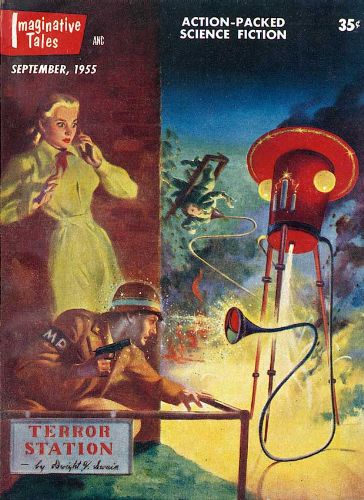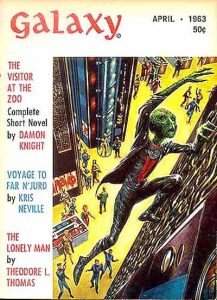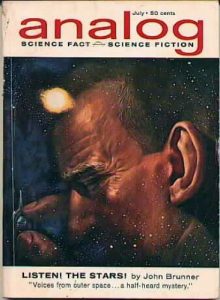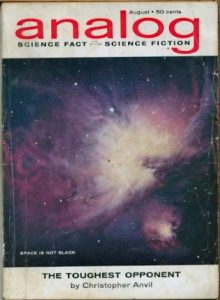Greetings all
I’m looking forward to this week’s magazine review, unlike last week’s. This one is not filled with any classic stories and there’s no Asimov, Heinlein, or Clarke, but all the stories were solid and filled with action. There’s one exception. It isn’t a classic, but the last story should be.
Table of Contents: http://www.isfdb.org/cgi-bin/pl.cgi?183245

I suspected I was going to enjoy this issue when I read the first words of the editorial by William L. Hamling. “An action story is more popular than any other type” (4). Previously, Imaginative Tales had focused on humorous stories, but they shifted their editorial focus starting in this one on action.
I like it, especially since it’s how I try to write.
By the way, Hamling had an interesting career. As an editor, he kept buying a poor artist’s fantasy cartoons. The cartoons weren’t very good and so Hamling never published them, but the artist needed the money. In 1953, the artist came to Hamling with a magazine idea. Hamling replied, “You can’t sell sex to the American public.” That artist was Hugh Hefner. Safe to say Hamling was wrong and Hefner stopped being poor.
Last week, I mentioned that this issue did something I wish they all did. It’s a simple Introducing the Author essay. Basically, they asked Dwight V. Swain to tell us about himself. It’s much like my weekly interviews, and I really enjoy getting to know the authors as people, especially ones I’m not terribly familiar with. In this case, it’s located inside the front and back covers, but I don’t really care where they would have placed it, given that inside the covers is such prime advertising territory, but I would have loved to have seen this sort of thing done routinely.
Swain’s story Terror Station is the cover story. I’d never read anything by him before, but I’ll remember the name. Terror Station is about a secret project in the desert. Stone, the project’s security officer, is returning to the facility when he sees a woman in the night running toward his car followed by some strange monster. He kills the monster, but the woman is dead. Guards from the lab rush up and immediately arrest him for killing her, much to his frustration.
Fury comes later when his expectations of the whole thing getting cleared up get squashed by everyone in the base thinking he’s guilty. None of these people, who were all friends and colleagues would give him any benefit of the doubt. To Stone it’s like they’re all filled with paranoia and fear which hadn’t been there when he left.
They send him to Reva, the psychologist, who happens to be one of Stone’s exes. She, at least, tries to help. In so doing, she discovers that he had once had encephalitis. In turn, he discovers why she’s there. The project wouldn’t have had a psychologist except she had her own work.
Stone discovers that her portion of the project is creating that fear and paranoia. He disables the device and all is back to normal, except they wonder at the source of the technology. Stone discovers that it comes from aliens who have landed near the base.
The manager of the project, MacDougal, it turns out, has been in league with these aliens. His project was going nowhere until they arrived, and he was afraid his career was about to crash and burn. He took bits of their technology to show his superiors that he was making progress while in turn helping the aliens.
What the aliens want is for us to capture all the krypton out of the air (about 1ppm) and give it to them as they use it for their technology. According to the story, though, what they want is for humanity to kill itself because krypton’s job is to keep our atmosphere intact. If we gave it to them, they could come back later to a dead planet, which to them would be a great joke.
Stone thwarts the aliens, figures out MacDougal’s part, and confronts him. MacDougal, however, has the drop on him and is about to kill him when Reva shoots him with Stone’s gun which she had picked up in an earlier fight. They then walk off, hand in hand.
A good, rip-roaring yarn, exactly like Hamling said he wanted.
Next is Coffin for Two by Winston K. Marks. Marks is another author I’d never read before, but I liked this story. A man returns from three years off Earth mining on Venus. Upon his return, he sees marked changes.
First, most people are walking around with a star on their forehead. Also, he finds his girl now making time with one of their friends. They get into a bit of a scuffle and his friend, who had never been much of an athlete, beats the heck out of the miner. Then the crew decides to go party to celebrate his return. On the way, the lead cab gets destroyed by a passing driver. His friends agree its too bad, because they would have enjoyed the party.
Too bad! The miner thinks two friends have just been killed and it’s “too bad?” It turns out that in the time he’s been gone, they’ve figured out a way to let people rest in a life support chamber (called coffins) and have their brain implant an automaton (called proxies) marked with a red star. His friends haven’t died, but they’ll take a bit of time to get another proxy.
At first, he is completely against the idea of getting his own proxy, but the friend who was now dating his old flame beats him up again. So he goes and gets fitted out. He hides the fact he’s using a proxy and confronts the old friend. Once the friend tries to kill him, he reveals he’s using a proxy and tells the friend to scram.
Now the old flame, who preferred the miner anyway, is waiting for an offer of marriage. However, he hesitates. He wanted to marry her three years ago, but how do proxies get married? Why, the share a coffin for two.
Following that is The Invisible Enemy by Jerry Sohl. Sohl is yet another write I hadn’t read before in this issue. This story is about a rescue attempt on another planet. The planet is a desert planet, out on the frontier, and the exploration vessel that came to it never left. Its crew vanished without a trace. A second ship came to look and the same thing happened to it.
Now comes a third ship. This one has a much larger crew and also includes a brand new computer with its own operator. Unfortunately, the commander of the ship despises the new equipment and scorn the operator as a mere civilian.
At first, his scorn is partially justified. The computer provides no answers, merely saying it has insufficient data. The crew starts exploring. And then they start disappearing, much like the crews of the previous ships. However, there’s nothing left behind. No shred of evidence.
Then, one of the crew is saved, briefly, from one of the attacks. He dies in the ship’s medical bay, raving of monsters. The commander insists that he give the boy a proper burial.
The computer now has sufficient data and says this is not advised. The tech goes to the commander and urges him not to follow through on the burial, but the commander ignores him and scorns the computer’s “advice.” He confines the tech to his quarters and continues with the burial.
However, the burial is a massacre. There are creatures swimming in the sand who are incredibly sensitive to the smell of blood. They scent the body and eat all the rest of the crew while the tech watches in horror. Then his horror is all the greater as he wonders if he can leave his quarters or is trapped here until he dies. Fortunately, the executive officer had believed him and left the door unlocked so he can flee the planet.
De-sert shark, do do, d-doo d-doo…
Henry Slesar’s The Brat is next. Really good story, with one of Slesar’s common twist endings. I become more and more a fan of Slesar with every story.
In this one, an alien is brought back to Earth for study. When the doctor examining alien died, the alien fled. They eventually found him in Nebraska, happily married with children.
Not everyone is happy about this, especially a hate group led by a man named Turesco. He is obsessed with finding all of these offspring before the alien, who can clearly interbreed with humans, corrupts our blood. They track down two, one who has mostly alien characteristics and a brat, who mostly looks human. They kill one and take one away.
However, the only way they can do this is with help from the government. A protector first class named Ward is assigned to the case and it is his suggestion that finally brings the two boys to bay. He does everything he can to save them, but Turesco and his men are just too much.
Then, at the least, we see that Ward also has those alien characteristics, albeit weaker. Turesco and his vision of “purity” is long past any hope of success.
What a great way to turn a crappy ending into a “villain gets his comeuppance” ending.
Last is Buck and the Space War by Mack Reynolds. I loved this story. When I saw it in the table of contents I immediately wondered if it was a Buck Rogers story, so I was excited to check it out. It’s not, but it might even be better.
It’s about a guy named Buck to whom the strangest things happen. If he goes fishing and doesn’t catch anything, it’s because a sea serpent swamp up the St. Johns River. That sort of thing.
Buck lives in Dupont, Florida, north of Orlando, south of Jacksonville. He’s a complete hick and he decides one day to go to Lake Dexter get him a mess of squirrels.
I’m going to stop here and say that Reynolds’ use of language in this story is fantastic. The story is light-hearted in many ways, and the specific words he chooses adds to the humor. Like “mess of squirrels.” Had Buck just wanted a few squirrels he could have stayed close to home, but he wanted a “mess.”
Anyway, squirrel hunting involves sitting and waiting until squirrels come to the hunter. Buck, being Buck, never gets a chance at a squirrel. Instead a damaged spaceship crashes on one side of the clearing where he waited. A small alien pops out and runs to a depression. A second spaceship lands and another alien, also small, pops out and the two start firing at each other.
Buck’s had enough of this, especially since he was sort of in the middle anyway. He picks up one of the aliens and carries him over to the other. He sets them down and asks what’s going on. One is a Martian, the other a Venusian, and the two have been battling for millennia. He tells them to stop with all this foolishness. He talks about treating people as you’d wish to be treated and overrides their protests about the other guy.
The two take notes and he sends them off back to Mars and Venus. There they take his words of wisdom, leaving him with the title of Holy One. The presumption at the end is that he ends the ancient war because the two take his backwoods common sense back to their planets as the root of a new religion.
It’s silly and impractical. There’s no way these events could actually end a war spanning thousands of years. But who cares? It’s a fun story and you really like Buck.
Again, this isn’t a great issue. There’s no Foundation story or anything like that. It is, however, exactly what Hamling aimed for. A magazine with lots of action, good stories that you want to find out what’s going on, and heroes you can root for.
Good stuff.
Next week I’ll review the Fantastic Universe from July, 1955. I’m excited because there’s stories by a number of good writers including Philip K. Dick and Murray Leinster. See you next week!
Next Week’s Issue: http://www.isfdb.org/cgi-bin/pl.cgi?89716
If you have any comments or would like to request I keep my eyes open for a specific issue or month, feel free to comment here or send an email to me at: rob@robhowell.org.
If you want to see previous reviews, the Mag Review category is here: https://robhowell.org/blog/?cat=432.
Have a great day.
Rob Howell
Author of the Shijuren-series of novels
- Website: www.robhowell.org
- Patreon: https://www.patreon.com/rhodri2112
- Blog: www.robhowell.org/blog
- Shijuren Wiki: http://www.shijuren.org/World+
of+Shijuren+Home - MeWe: https://mewe.com/i/rob.howell1
- Facebook Author Page: https://www.facebook.com/robho
well.org/ - Twitter: https://twitter.com/Rhodri2112



